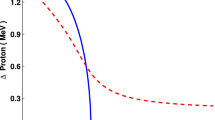Abstract
The gap parameter of the standard BCS model is replaced by the order parameter of the modified Ginzburg–Landau theory. Using this new form of the BCS model, the energy, entropy, and heat capacity of \(^{93,94,95}\)Mo nuclei are calculated. The results are compared with the experimental data and standard BCS results. Since the order parameter does not drop to zero at a critical temperature, our results for thermal properties are free of singularities. We have shown that the heat capacity as a function of temperature behaves smoothly and it is highly in agreement with the experimental heat capacity, while heat capacity behaves singularly and discontinuously in the standard BCS model. A smooth peak in the heat capacity is observed which is interpreted as a signature of the transition from the superfluid to the normal phase.





Similar content being viewed by others
References
J. Bardeen, L.N. Cooper, J.R. Schrieffer, Theory of superconductivity. Phys. Rev. 108, 1175–1204 (1957). doi:10.1103/PhysRev.108.1175
L.G. Moretto, Statistical description of a paired nucleus with the inclusion of angular momentum. Nucl. Phys. A 185, 145–165 (1972). doi:10.1016/0375-9474(72)90556-8
A.N. Behkami, J.R. Huizenga, Comparison of experimental level densities and spin cutoff factors with microscopic theory for nuclei near A = 60. Nucl. Phys. A 217, 78–92 (1973). doi:10.1016/0375-9474(73)90624-6
P. Moller, J.R. Nix, Nuclear pairing models. Nucl. Phys. A536, 20–60 (1992). doi:10.1016/0375-9474(92)90244-E
N. Sandulescu, O. Civitarese, R.J. Liotta, Temperature dependent BCS equations with continuum coupling Phys. Phys. Rev. C 61, 044317 (2000). doi:10.1103/PhysRevC.61.044317
K. Kaneko, M. Hasegawa, Pairing transition of nuclei at finite temperature. Nucl. Phys. A 740, 95–105 (2004). doi:10.1016/j.nuclphysa.2004.05.001
Z. Kargar, Pairing correlations and thermodynamical quantities in \(^{96,97}\)Mo. Phys. Rev. C 75, 064319 (2007). doi:10.1103/PhysRevC.75.064319
R. Razavi, Ratio of neutron and proton entropy excess in \(^{121}\)Sn compared to \(^{122}\)Sn. Phys. Rev. C 86, 047303 (2012). doi:10.1103/PhysRevC.86.047303
H.J. Lipkin, Collective motion in many-particle systems: Part 1. The violation of conservation laws. Ann. Phys. (NY) 9, 272–291 (1960). doi:10.1016/0003-4916(60)90032-4
Y. Nogami, Improved superconductivity approximation for the pairing interaction in nuclei. Phys. Rev. B 134, 313–321 (1964). doi:10.1103/PhysRev.134.B313
H.C. Pradhan, Y. Nogami, J. law, Study of approximations in the nuclear pairing-force problem. Nucl. Phys. A 201, 357–368 (1973). doi:10.1016/0375-9474(73)90071-7
N.D. Dang, Influence of particle number fluctuations and vibrational modes on thermodynamic characteristics of a hot nucleus. Z. Phys. A 335, 253–264 (1990). doi:10.1007/BF01304703
L.G. Moretto, Pairing fluctuations in excited nuclei and the absence of a second order phase transition. Phys. Lett. B 40, 1–4 (1972). doi:10.1016/0370-2693(72)90265-1
Z. Kargar, V. Dehghani, Statistical pairing fluctuation and phase transition in \(^{94}\)Mo. J. Phys. G 40, 045108 (2013). doi:10.1088/0954-3899/40/4/045108
P. Arve, G.F. Bertsch, B. Lauritzen, G. Puddu, Static path approximation for the nuclear partition function. Ann. Phys. (NY) 183, 309–319 (1988). doi:10.1016/0003-4916(88)90235-7
B. Lauritzen, A. Anselmino, P.F. Bortignon, R.A. Broglia, Pairing phase transition in small particles. Ann. Phys. (NY) 223, 216–228 (1993). doi:10.1006/aphy.1993.1032
G. Puddu, P.F. Bortignon, R.A. Broglia, The RPA-SPA approximation to level densities. Ann. Phys. (NY) 206, 409–439 (1991). doi:10.1016/0003-4916(91)90006-T
H. Attias, Y. Alhassid, The Perturbed static path approximation at finite temperature: observables and strength functions. Nucl. Phys. A 625, 565–597 (1997). doi:10.1016/S0375-9474(97)00486-7
R. Rossignoli, N. Canosa, P. Ring, Fluctuations and odd-even effects in small superfluid systems. Ann. Phys. (NY) 275, 1–26 (1999). doi:10.1006/aphy.1999.5914
B. Mühlschlegel, D.J. Scalapino, B. Denton, Thermodynamic properties of small superconducting particles. Phys. Rev. B 6, 1767–1777 (1972). doi:10.1103/PhysRevB.6.1767
P. Mohammadi, V. Dehghani, A.A. Mehmandoost-Khajeh-Dad, Applying modified Ginzburg–Landau theory to nuclei. Phys. Rev. C 90, 054304 (2014). doi:10.1103/PhysRevC.90.054304
A. Schiller et al., Critical temperature for quenching of pair correlations. Phys. Rev. C 63, 021306(R) (2001). doi:10.1103/PhysRevC.63.021306
M. Guttormsen et al., Thermal properties and radiative strengths in \(^{160, 161, 162}\)Dy. Phys. Rev. C 68, 064306 (2003). doi:10.1103/PhysRevC.68.064306
E. Melby et al., Observation of thermodynamical properties in the \(^{162}\)Dy, \(^{166}\)Er, and \(^{172}\)Yb nuclei. Phys. Rev. Lett. 83, 3150–3153 (1999). doi:10.1103/PhysRevLett.83.3150
R. Chankova et al., Level densities and thermodynamical quantities of heated \(^{93 - 98}\)Mo isotopes. Phys. Rev. C 73, 034311 (2006). doi:10.1103/PhysRevC.73.034311
K. Kaneko et al., Breaking of nucleon Cooper pairs at finite temperature in \(^{93-98}\)Mo. Phys. Rev. C 74, 024325 (2006). doi:10.1103/PhysRevC.74.024325
E. Algin et al., Thermodynamic properties of \(^{56, 57}\)Fe. Phys. Rev. C 78, 054321 (2008). doi:10.1103/PhysRevC.78.054321
J.H.C. Pauli, V.V. Pashkevich, V.M. Strutinsky, A method for solving the independent-particle Schr\(\ddot{\text{ o }}\)dinger equation with a deformed average field. Nucl. Phys. A 135, 432–444 (1969). doi:10.1016/0375-9474(69)90174-2
S. Cwiok, J. Dudek, W. Nazarewicz, J. Skalski, T. Werner, Single-particle energies, wave functions, quadrupole moments and g-factors in an axially deformed woods-saxon potential with applications to the two-centre-type nuclear problems. Comput. Phys. Commun. 46, 379–399 (1987). doi:10.1016/0010-4655(87)90093-2
Z. Patyk, A. Sobiczewski, Ground-state properties of the heaviest nuclei analyzed in a multidimensional deformation space. Nucl. Phys. A 533, 132–152 (1991). doi:10.1016/0375-9474(91)90823-O
NRV: low energy nuclear knowledge base, http://nrv.jinr.ru/nrv
T. Ericson, The statistical model and nuclear level densities. Adv. Phys. 36, 425–511 (1960). doi:10.1080/00018736000101239
Y.F. Niu, Z.M. Niu, N. Paar, D. Vretenar, G.H. Wang, J.S. Bai, J. Meng, Pairing transitions in finite-temperature relativistic Hartree–Bogoliubov theory. Phys. Rev. C 88, 034308 (2013). doi:10.1103/PhysRevC.88.034308
Author information
Authors and Affiliations
Corresponding author
Rights and permissions
About this article
Cite this article
Dehghani, V., Forozani, G. & Benam, K. Calculating the thermal properties of 93,94,95Mo using the BCS model with an average value gap parameter. NUCL SCI TECH 28, 128 (2017). https://doi.org/10.1007/s41365-017-0284-x
Received:
Revised:
Accepted:
Published:
DOI: https://doi.org/10.1007/s41365-017-0284-x



